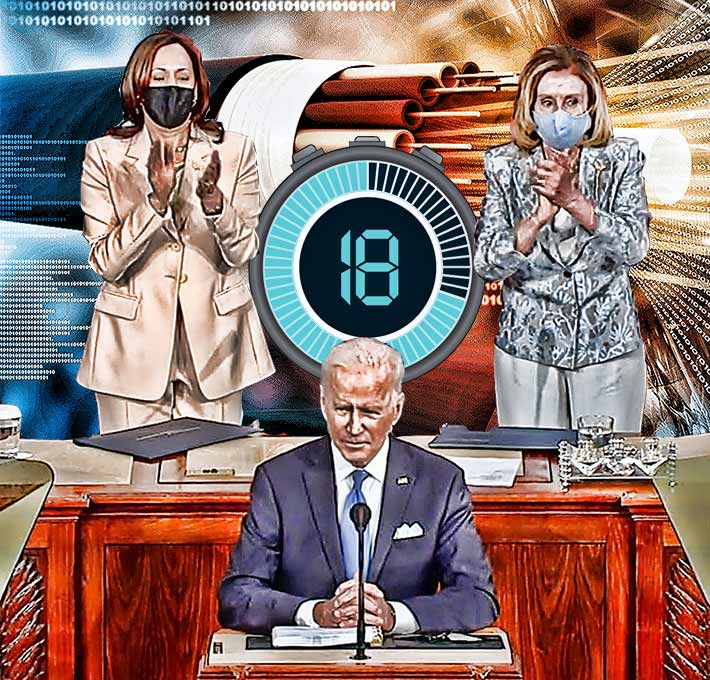
President Biden unveiled a major proposal of investing in America describing it as “a blue-collar blueprint to build America,” heavily promoting unions. He spent 18 seconds discussing the need for universal broadband.
If you didn’t have an additional 70 minutes to spare last evening to watch President Biden’s fist-bumping prime-time joint address to Congress to discover how his leadership and administration’s actions will alter the industry, it can be summed up in one sentence: The internet was a science breakthrough, America needs high speed internet, wind turbine blades should be built in Pittsburg and unions are good.
Much of his remarks were related to selling his $1.8 trillion plan to boost programs for families, students and children and a $2.3 trillion jobs and infrastructure plan that need congressional approval.
His American Jobs Plan released March 31, 2021, below, provides $100 billion to revitalize America’s digital infrastructure, but it presents no details that will assist in contractor or supplier planning.
During his speech he said it creates jobs by connecting every American with high-speed internet, including 35% of rural Americans who still don’t have it.
“This will help our kids and businesses succeed in a 21st Century economy. And I am asking the Vice President to help lead this effort,” President Biden said.
“The American Jobs Plan is a blue-collar blueprint to build America. And, it recognizes something I’ve always said. Wall Street didn’t build this country. The middle class built this country. And unions build the middle class. And that’s why I’m calling on Congress to pass the Protecting the Right to Organize Act – the PRO Act — and send it to my desk to support the right to unionize,” he said.
In his drive to use products manufactured in America, the President said, “There’s no reason the blades for wind turbines can’t be built in Pittsburgh instead of Beijing.”
FROM THE AMERICAN JOBS PlAN
Revitalize America’s digital infrastructure:
Generations ago, the federal government recognized that without affordable access to electricity, Americans couldn’t fully participate in modern society and the modern economy. With the 1936 Rural Electrification Act, the federal government made a historic investment in bringing electricity to nearly every home and farm in America, and millions of families and our economy reaped the benefits. Broadband internet is the new electricity. It is necessary for Americans to do their jobs, to participate equally in school learning, health care, and to stay connected. Yet, by one definition, more than 30 million Americans live in areas where there is no broadband infrastructure that provides minimally acceptable speeds. Americans in rural areas and on tribal lands particularly lack adequate access. And, in part because the United States has some of the highest broadband prices among OECD countries, millions of Americans can’t use broadband internet even if the infrastructure exists where they live. In urban areas as well, there is a stark digital divide: a much higher percentage of White families use home broadband internet than Black or Latino families. The last year made painfully clear the cost of these disparities, particularly for students who struggled to connect while learning remotely, compounding learning loss and social isolation for those students.
The President believes we can bring affordable, reliable, high-speed broadband to every American through a historic investment of $100 billion. That investment will:
- Build high-speed broadband infrastructure to reach 100 percent coverage.
The President’s plan prioritizes building “future proof” broadband infrastructure in unserved and underserved areas so that we finally reach 100 percent high-speed broadband coverage. It also prioritizes support for broadband networks owned, operated by, or affiliated with local governments, non-profits, and co-operatives—providers with less pressure to turn profits and with a commitment to serving entire communities. Moreover, it ensures funds are set aside for infrastructure on tribal lands and that tribal nations are consulted in program administration. Along the way, it will create good-paying jobs with labor protections and the right to organize and bargain collectively. - Promote transparency and competition.
President Biden’s plan will promote price transparency and competition among internet providers, including by lifting barriers that prevent municipally-owned or affiliated providers and rural electric co-ops from competing on an even playing field with private providers, and requiring internet providers to clearly disclose the prices they charge. - Reduce the cost of broadband internet service and promote more widespread adoption.
President Biden believes that building out broadband infrastructure isn’t enough. We also must ensure that every American who wants to can afford high-quality and reliable broadband internet. While the President recognizes that individual subsidies to cover internet costs may be needed in the short term, he believes continually providing subsidies to cover the cost of overpriced internet service is not the right long-term solution for consumers or taxpayers. Americans pay too much for the internet – much more than people in many other countries – and the President is committed to working with Congress to find a solution to reduce internet prices for all Americans, increase adoption in both rural and urban areas, hold providers accountable, and save taxpayer money.
















